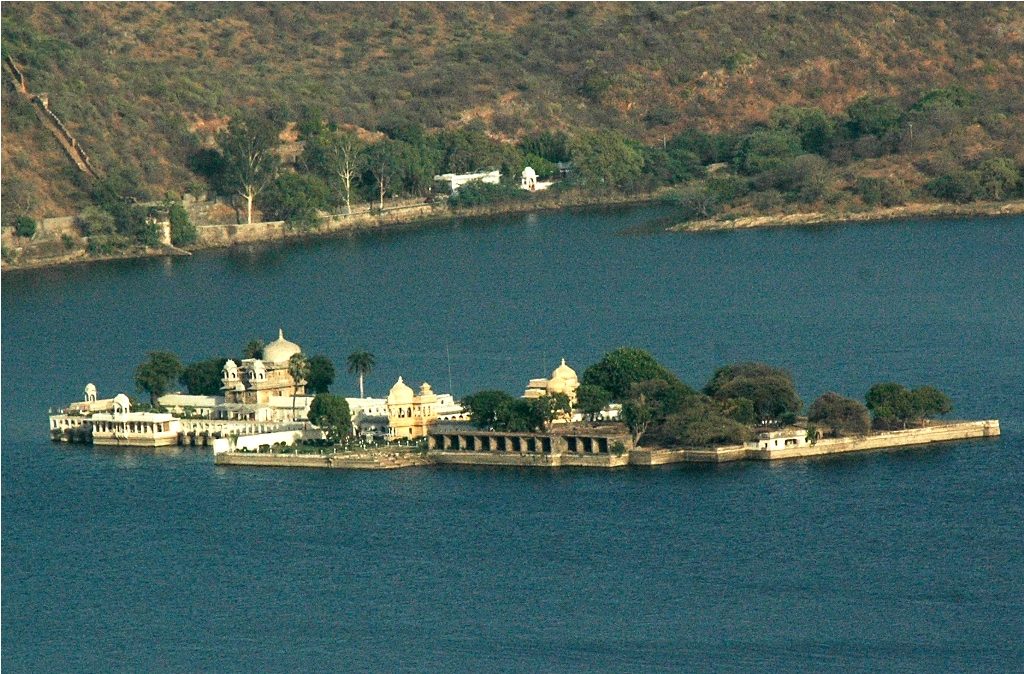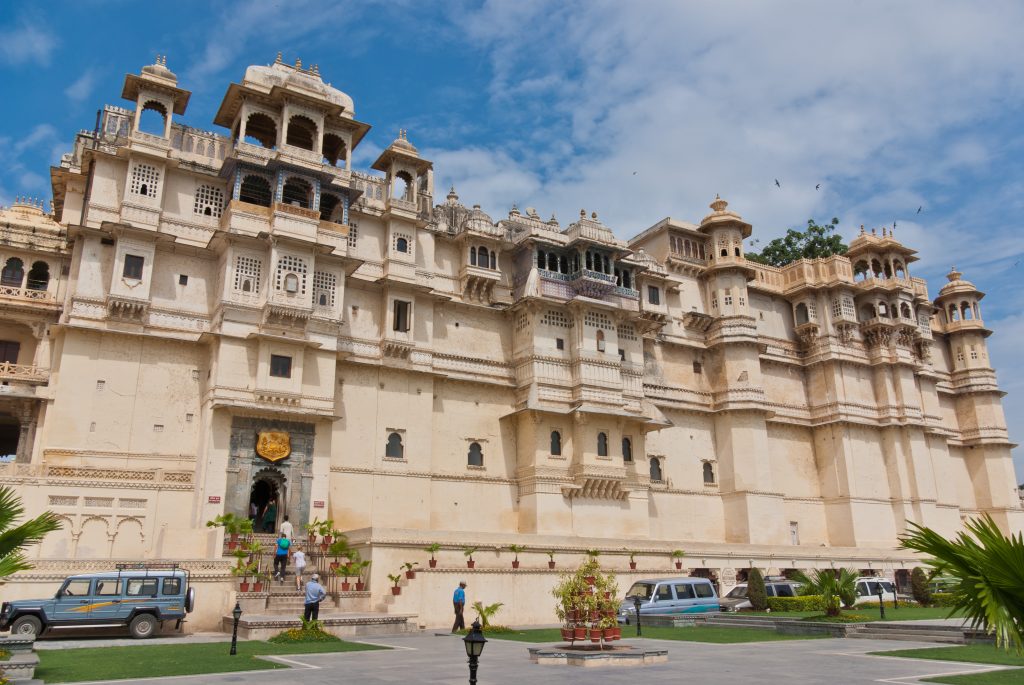Jag Mandir Royal Palace Udaipur :-

Jag Mandir is a palace built on an island in the Lake Pichola. It is also called the “Lake Garden Palace”. The palace is located in Udaipur city in the Indian state of Rajasthan. Its construction is credited to three Maharanas of the Sisodia Rajputs of Mewar kingdom. The construction of the palace was started in 1551 by Maharana Amar Singh, continued by Maharana Karan Singh (1620–1628) and finally completed by Maharana Jagat Singh I (1628–1652). It is named as “Jagat Mandir” in honour of the last named Maharana Jagat Singh. The royal family used the palace as a summer resort and pleasure palace for holding parties. The palace served as a refuge to asylum seekers on two separate occasions.
City Palace Udaipur :-

The City Palace stands tall over Pichola Lake, having served as an abode for the ruling royalty. Construction was begun by Maharana Udai Singh and was continued by successive Maharanas who incorporated several palaces and structures to the complex. Interestingly, each addition preserved the original style of the design. Visitors enter the palace through Bari Pol (the Big Gate) which leads one to Tripolia (the Triple Gate) where it was once a custom to distribute the Maharaja’s weight in gold and silver to his subjects. It now serves as the main ticket office. The palace has numerous balconies, cupolas and towers that overlook Pichola Lake. The structure is just as beautiful inside as it is spectacular from the outside. Each palace is designed in a unique way, and decorations like mirrored tiles, paintings, glass work and ornamental tiles bring to life the opulence of the era. Today, the main section of the palace has been converted into a museum that houses a large collection of artifacts.
City palace Jaipur :-
There is also the Dewan-I-Aam which has now been converted into an art gallery and has unusual ancient Hindu manuscripts, exquisite work of art belonging to Persion, Mughal and Rajasthani school of art. The Dewan-I-Khas is conspicuous by its two large exquisite silver vessels, which were exclusively made for Maharaja Madho Singh. These vessels served the purpose of storing the holy Ganga water during the erstwhile ruler’s much talked about trip to England.
The magnificent Chandra Mahal which is all of seven storied is now the residence of the present Maharaja of Jaipur. Needless to say, the palace with its exquisite paintings, flower – patterned décor, parapets that dazzle with mirrors and intricately carved ceilings makes this palace an enchanting abode. Each of the seven stories serves a distinctive purpose and are appropriately named. For instance, the Sukh Niwas or the hall of pleasure serves as the drawing cum dining room of the Maharaja while the Shova Niwas or the hall of beauty is conspicuous by its mirror coated parapets which dazzle with a million rays when lit up.
Hawa Mahal “Palace Of wind “ :-
built by Maharaja Sawai Pratap Singh for royal women to view the busy streets of Johari Bazaar, while staying veiled behind the jharokhas. Hawa Mahal is a pyramid-shaped facade with five stories. It has 953 small windows decorated with tiny lattice work. These pink sandstone windows commonly known as “Jharokhas” are constructed in such a style, that it looks like a giant honeycomb. The air circulation through windows represents the marvelous touch of Mughal designing, which keeps the Palace always cool. The small screened balconies and arched roofs with hanging cornices enhance the beauty of the Palace. The Pyramidal outline and replication of pattern makes it more attractive in appearance.
As a matter of fact, Hawa Mahal is believed to build for the women of the Royal Families, since they had to observe strict “purdah” syetem (veil over the face). The small windows and screened balconies serve the women to watch processions and different activities taking place on the main streets. In this manner, the women could enjoy a sense of freedom without showing themselves.
Jal Mahal Palace :–
The palace architecture boasts of a typical Rajput and Mughal style which is quite similar to that of Amer Fort. Made in red sandstone, the palace is actually five-storied where only the top story is visible (rest are submerged under water).
Gajner Palace :-
The palace is situated about 20kms from the city of Bikaner and is set up beside a beautiful lake called Gajner Lake. One has the opportunity to enjoy nature walks, boating and desert safaris near the palace.
Lalgarh Palace:-
Another architectural delight in Bikaner is Lalgarh Palace. The palace also consists of a museum that is situated inside Ganga Niwas. Here one can see the Miniature Paintings that are related to Bikaner school of art, Terracota Wares and armors. There is also a library that has a good collection of Sanskrit Manuscripts written on parchments, plaques of silver, copper and gold. The artifacts belonging to Harappa civilization and Kushan and Gupta Age are also preserved here.
Fateh Prakash Palace Chittorgarh
You can also visit Fateh Prakash Palace, which was built by Maharaja Fateh Singh in 1920. Built beautifully, the palace now has been converted into the government museum.
Padmini Palace Chittorgarh
Built beside a pool, this is a magnificent palace. It was here that Rana Rattan Singh showed a glimpse of Rani Padmini to Allauddin Khilji. Rani Padmini stood in the Zenana Mahal, and her reflection was visible to Khilji in a mirror placed in the main hall. Khilji, after having a glimpse of the queen, was smitten by her beauty and with the passion to posses her invaded Chittaur.
Balsamand Lake palace
Balsamand Lake is a lake situated 5 km from Jodhpur on Jodhpur-Mandore Road. This lake is a popular picnic spot, built in 1159 AD by Gurjara-Pratihara rulers. It was designed as a water reservoir to provide water to Mandore. The lake has a length of one km, breadth of 50 m and a depth of 15 m.
The Balsamand Lake Palace was built later as a summer palace on its shore. The lake is surrounded by lush green gardens that house groves of trees like mango, papaya, pomegranate, guava and plum. Animals and birds like the jackal and peacock also call this place home.
City Palace Alwar
The City Palace of Alwar is known as the Vinay Vilas Mahal. It is standing huge in the heart of Alwar City of Rajasthan. The City Palace, of Alwar, was built up by Raja Bakhtayar Singh in the year 1793. The building is a perfect example of Indo-Islamic architecture. The prehistoric city of Alwar is settled at the slopes of the Aravalli Hills has converted into a crowded trade center in recent times. But its rich history has left many examples through many temples, forts, tombs, gardens and palaces.
Alwar is one of the oldest cities of Rajasthan and ii has always been a favorite place for the archaeologists. The Alwar city is settled in the year past 1500BC. It is also called Matsya Desh as Pandavas had spent thirteen years at this place. Alwar is the best place where you can take a relaxed walk through the many forts and tombs that depict the picture of olden times. Built by Raja Bakhtayar Singh in the year 1793, Vinay Vilas Mahal depicts the architectural beauty of the bygone era.
Government Museum City Palace Alwar :- The museum inside the city palace Alwar is known by the name of Government Museum Alwar which was established in 1940. The collections on the display are the artifacts of the royal family of the palace which includes about 9702 coins, 2270 arms & weapons, 234 sculptures, 35 metal objects, 2565 paintings & manuscripts and much more.
Garh Palace Bundi
Maharao Balwant Singh started the construction of Garh Palace in Bundi. The Garh Palace is the complex of numerous palaces which were built by rulers of different times. Most of the palaces were built between the 17th and 18th centuries. After a long period of neglection Garh palace again gaining its recognition. Garh Palace is known for its artistic Rajput style architecture which can be easily seen in its Jharokhas and pillars. Among other palaces which are famous for their decoration like Chhatra Mahal, Phool Mahal and Badal Mahal, there is a somewhat separate Ummed Mahal, famously known as ‘Chitrashala‘. Chitrashala has fascinating pavilion and a gallery of miniature murals located on a raised platform above a garden platform. It has entrance from other side and no entry fee with 8 am to 5 pm timings.
